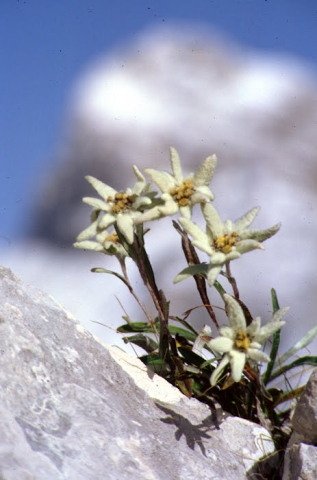
Edelweiss (Leontopodium alpinum)
| Size |
|
| Blooming period |
|
| Habitat |
|
| Distribution |
|
| Kingdom |
|
| Phylum |
|
| Class |
|
| Order |
|
| Family |
|
| Genus |
|
| Species |
|
The most famous of the mountain flowers, it grows in remote and inaccessible places above 1500 m above sea level. The inflorescence consists of small yellow flowers surrounded by whitish-silver leaves.
The edelweiss is most commonly found in alpine meadows and rocky crevices.
However, if you want to see it, you'll need to stretch your legs a bit. It grows in remote and hard-to-reach places above 1500 meters in elevation. The very name planika (in Slovenian) suggests that the plant thrives in mountainous regions.
In Slovenia, edelweiss can be found in the Julian and Kamnik-Savinja Alps, the Karavankas, Ratitovec, Snežnik and in the Trnovo forest plateau.
One of the most famous mountain flowers also grows in other high-altitude regions in Italy, Austria, and Germany, as well as in the Carpathians, the Pyrenees, and even in South America.
The edelweiss is a perennial plant. Its stem grows between five and twenty centimeters tall.

The flower is actually just the yellow part in the center, which is technically an inflorescence. It consists of 5 to 8 small yellow flowers, each about half a centimeter in size, surrounded by the characteristic whitish-silver leaves. It blooms from July to September and is pollinated by flies and beetles.
The entire plant is covered in whitish hairs. These hairs protect the edelweiss from heat loss and excessive evaporation, as it grows in extremely dry and windy habitats.
DID YOU KNOW?
- The small yellow flowers of the edelweiss, which look like eyes, have also given it the nickname "eye-flower" (očnica in Slovene). In the past, it had several other names such as "kosmatinka," "zvezdica," "pečnica," and "skalarica."
- In Slovenia, the edelweiss was protected as early as 1896.
- The name "planika" has been adopted by numerous mountaineering and tourist associations, scout groups, a shoe factory, and even a well-known dairy in Kobarid. A mountain hut below Triglav is also named Dom Planika.
- The edelweiss is the national flower of Switzerland.
- It is also cultivated as an agricultural crop. Products like shampoos, creams, and tonics are made from it, and it is used in herbal medicine.
- In Germanic languages, it is known as Edelweiss. The song Edelweiss (translated as "White Flower") is a central piece in the musical Moje pesmi, moje sanje, and the film adaptation with the same title won five Academy Awards (Oskar)
Thank you.

